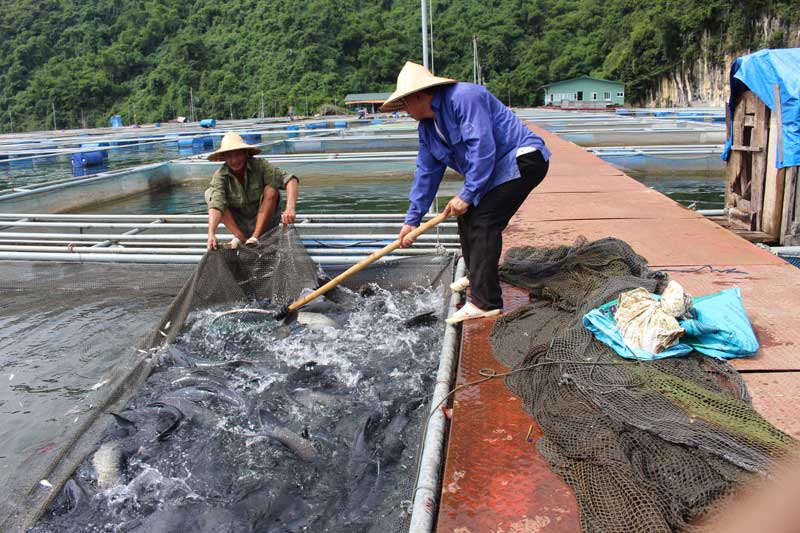
(HBO) - Blessed with favourable natural conditions of the lake area, the caged fish specialty of Hoa Binh province has been known wide and far by many consumers.
Along with increasing the number of cages, attention
has been paid to strictly controlling food safety quality, the factor that
determines the sale of product.
The linkage between production and sale of products of fish raised in cages in Da
river in line with the value chain was built by the locality in 2017. The model
continues to prove effective, creating an open direction for businesses and
locals to participate in the production and trading of local cage-fish, thus
reaching a larger market.
 The Da river caged fish chain meeting VietGAP standard
produced by the Hai Dang Seafood Co., Ltd in Cao Phong district and Hoa Binh City is
favoured by Hanoi consumers.
The Da river caged fish chain meeting VietGAP standard
produced by the Hai Dang Seafood Co., Ltd in Cao Phong district and Hoa Binh City is
favoured by Hanoi consumers.
Hanoi'
customers now prefer dishes processed from Da River specialties when they visit
more than 30 restaurants which join the clean food chain provided by the Hai
Dang Seafood Co., Ltd. The volume of fish supplied by the company to the market
has been increasing thanks to its prestige and its products meeting VietGAP
standards.
Notably,
connection programmes for sales have been conducted regularly by the provincial
Department of Agriculture and Rural Development. The Da river fish products
were introduced and registered to participate in the safe meal programme in Hanoi and the trade promotion
conference in Son La province.
Especially, at "Da river fish week in 2018” to introduce and promote clean
fish specialty in Hanoi, more than 1 tonne of Da river fish belonging to the
value chain was sold.
With key products made from traditional fish species such as black, yellow and
dotted hemibagrus, cranoglanis,
sturgeon, carp, black pike, and tilapia, Hoa Binh has two units and 10
households joining the value chain with a total of over 300 fish cages, supplying
over 800 tonnes of products per year.
Da Bac district has Hien
Luong agro-forestry business and production service cooperative and 10
households participating in the chain, with 93 fish cages, turning out over 300
tonnes of products per year.
Currently,
in addition to supplying safe fish products to the Hoa Binh market, a system of
shops to introduce and supply safe cage fish in Da river was formed in Hanoi.
Hoa
Binh’s fish products were certified to meet standards on food safety and
origin. This helps the caged fish value chain in Da river have stable market,
with the selling price always 20-30 percent higher than that of same product in
the market./.
According to data from the Hoa Binh Provincial Party Committee, the industrial production index for the first six months of 2025 is estimated to have increased by 20% compared to the same period last year. This marks the highest year-on-year growth rate for this period since 2020.
In the first six months of 2025, Hoa Binh province’s export turnover was estimated at 1.145 billion USD, marking an 18.11% increase compared to the same period in 2024. Import turnover was estimated at $ 804 million, a 17.15% increase, which helped the province maintain a positive trade balance.
The lives of the ethnic minority farmers in Tan Lac district have gradually improved thanks to the new directions in agricultural production. This is a testament to the collective strength fostered through the professional associations and groups implemented by various levels of the district’s Farmers’ Union.
With the motto the "product quality comes first,” after nearly one year of establishment and operation, Muong village’s Clean Food Agricultural and Commercial Cooperative, located in Cau Hamlet, Hung Son Commune (Kim Boi district), has launched reputable, high-quality agricultural products to the market that are well-received by consumers. The products such as Muong village’s pork sausage, salt-cured chicken, and salt-cured pork hocks have gradually carved out a place in the market and they are on the path to obtaining the OCOP certification.
In the past, the phrase "bumper harvest, rock-bottom prices" was a familiar refrain for Vietnamese farmers engaged in fragmented, small-scale agriculture. But today, a new spirit is emerging across rural areas of Hoa Binh province - one of collaboration, organisation, and collective economic models that provide a stable foundation for production.
Maintaining growing area codes and packing facility codes in accordance with regulations is a mandatory requirement for agricultural products to be eligible for export. Recently, the Department of Agriculture and Environment of Hoa Binh province has intensified technical supervision of designated farming areas and packing facilities to safeguard the "green passport" that enables its products to access international markets.



 The Da river caged fish chain meeting VietGAP standard
produced by the Hai Dang Seafood Co., Ltd in Cao Phong district and Hoa Binh City is
favoured by Hanoi consumers.
The Da river caged fish chain meeting VietGAP standard
produced by the Hai Dang Seafood Co., Ltd in Cao Phong district and Hoa Binh City is
favoured by Hanoi consumers.